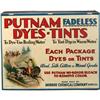OLD PUTNAM DYES... acid, fiber-reactive, or blend?
Name: Kay
Country or region: WI, USA
Message: OLD PUTNAM DYES... acid, fiber-reactive, or blend? Old packages labeled 15-cents say it is good for silk, wool, cotton, rayon and mixed goods except celanese. It ~sounds~ like a Rit-type-blend. But, as some older products over-hyped, is it possible that this is purely an acid dye or purely fiber-reactive which won't perform on some fibers? Any help?

They're not fiber reactive dyes. Old packages of dyes are almost never fiber reactive dyes. Putnam dyes were introduced just before the end of the nineteenth century, long before the development of the first fiber reactive dye in 1956.
They're not purely acid dyes, either, because, if they were, they would never have been advertised for cotton, when direct dyes were so readily available and cheap. It's most likely that they were an all-purpose dye, that is, a blend of direct dyes for cellulose fibers and acid dyes for protein fibers. (The Celanese fiber they were not recommended for was the synthetic fiber acetate, which requires disperse dyes.) As a rule, all-purpose dyes are inferior to more carefully selected acid dyes, for protein fibers, or to fiber reactive dyes, for plant-based fibers. The direct dye and the type of acid dye used in all-purpose dyes are both less washfast than other choices.
E. H. Rosborough's book "Tying & Fishing Fuzzy Nymphs" says that Putnam dye was stronger than Rit dye, so much so that one-third less of it should be used, by volume. (A stronger dye powder would not have been difficult to achieve, Rit dye contains far more salt and detergent than it does dye.)
Since they are old, chances are that they include some benzidine-based dyes, as was common for all-purpose dyes right up until the early nineteen-eighties. Benzidine-based dyes, if absorbed into the body, can regenerate benzidine as the body tries to break them down. Benzidine is a known cause of bladder cancer. Don't allow any of this dye to contact your skin, nor any food preparation areas or equipment.
Unlike fiber reactive dyes, all-purpose dyes might still work even decades after their manufacture, if you can get them to dissolve at all. However, because of the hazards of benzidine-based dyes, I don't recommend you use these unless you are skilled in the use of all applicable safety procedures.
Interestingly, Amazon currently has a used copy for sale of an old Putnam How to Dye Manual, offered for an extremely high price considering that it's no more than a typewritten pamphlet. The table of contents listed includes "How to Dye in the Washing Machine", "Dye Instructions", and even "Dyeing Upholstered Furniture". I've heard of several disasters when people tried to dye upholstered furniture with Rit dye without first removing the fabric from the furniture, since they weren't able to properly rinse off the excess dye.
(Please help support this web site. Thank you.)
(Please help support this web site. Thank you.)
Posted: Wednesday - January 25, 2012 at 10:28 AM
Follow this blog on twitter here.
Quick Links
- All About Dyes & Dyeing Top -
- Top of this blog -
- FAQ -
- The Dye Forum -
- How to Tie Dye - How to Batik -
- Books - Toys - Plants -
- Top of this blog -
- FAQ -
- The Dye Forum -
- How to Tie Dye - How to Batik -
- Books - Toys - Plants -
More in this category:
- -
Statistics
Total entries in this blog:
Total entries in this category:
Published On: Aug 29, 2012 02:49 PM
Total entries in this category:
Published On: Aug 29, 2012 02:49 PM
